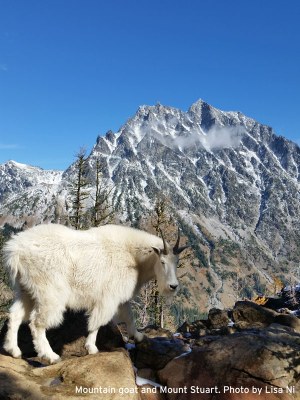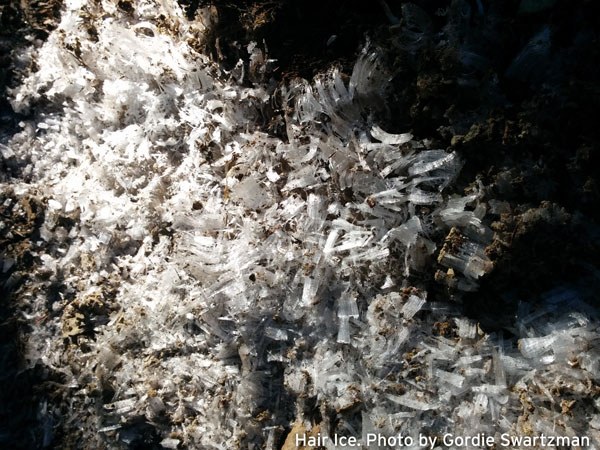
by Gordie Swartzman, Mountaineers Seattle Naturalists Committee Chair
We all know about the therapeutic value of spending time in nature - but nobody practices it better than Mountaineers.
From hiking in the spring, summer and autumn, to snowshoeing and skiing or snowboarding in the winter, and kayaking, canoeing, and climbing mostly in the summer, we steadfastly pursue our activities throughout the year.
As we age, many of us experience a shift from fast-paced aerobic activities to more contemplative ones. Even though our choice of activities may remain the same, the way we approach them differs. We learn to appreciate both our own personal strengths (and limitations) along with the natural beauty of wild places.
Throughout the seasons, natural ecosystems change in response to changes in climatic conditions. Birds move offshore and onshore, migrate long or short distances — or move between mountains and lowlands. Observing our environment in different seasons, we see striking changes beyond the obvious rainfall, snowfall, windfall and sunfall conditions that typify our hiking environment. Each season highlights a different part of the ecosystem.
Members of The Mountaineers Naturalist group spend a good part of their time in nature engaged in activities that help us understand both the types of creatures and plants that inhabit our natural world, and also their interconnections and habitat adaptations. Understanding and appreciating the complexity, diversity and interactions help us to better understand how we too are connected with that system — the place we all come from and to which we are indebted for our very survival.
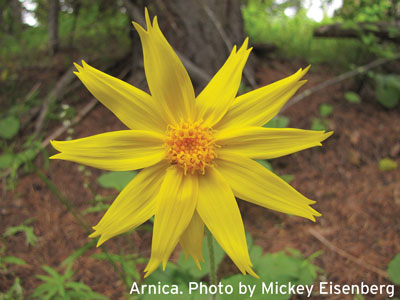 From sacred to mundane
From sacred to mundane
In recognizing the complexity of ecosystems, we approach our study of nature one step at a time. We share our knowledge with each other to satisfy the curiosity we all feel, and the wonder of being in the natural world. In looking at my own exploration of nature, I carry a memory of childhood experiences that informs a great deal of my passion and pursuit of 'aha!' experiences that seem to come almost out of a primordial soup when I am outdoors. Awareness and wonder recharge my batteries, and satisfy my need to connect with something larger than myself. I try to look at my natural experiences through new eyes in each different opportunity.
With that, we carry our agendas of personal quests as we venture into the outdoors — building upon our knowledge from one trip to the next. As humans, we have a need to systematize things and to name them — to create order out of chaos. Naturalists are no exception. In fact I admit to having more than an average dose of name-its, as if life were a naming game with first prize going to the person who knows the most names on sight.
Nature study can initially appear to have a steep learning curve. Much of this learning occurs on hikes or 'field trips' where we often walk slowly, ask lots of questions, and identify just about everything we can. There is always something new to explore around the next bend in the trail. Consider the activities in our recent hike-of-the-month to Barclay Lake. It was a busy Saturday at the end of September and the trail was full of hikers, most of whom flew by us without looking twice. Almost every hiker saw the massive face of Mt. Baring looming over the lake — but how many saw the bone lichen, hypogymnium, which took advantage of the recent rains to develop fruiting bodies? Though the spatial scale of the two are vastly different, they are equally magnificent and worthy of appreciation. It is through nature study that we learn how to see, how to notice and how to identify what we are looking at. Appreciating the natural wonders (in both the large and small sense) gives us flexibility to freshen our experience no matter what the conditions. I think this is the secret of nature study.
Another strong aspect of nature study is that it is much like the oral tradition carried by indigenous peoples. Auditory stimulus piques our imagination as lore is developed around our experience of nature. Life is motivated largely through a good story. When I teach plant, animal or bird identification, I often remember some fact or story, as well as the person I learned it from, and realize that I am in turn passing it on to others. I find this aspect of learning and teaching extremely satisfying and it gives me an intimate feeling in knowing that it has been personalized, as if our 'tribe' consists of those before me and I am helping maintain the continuity of thought. I want my natural experiences within and outside the study group to motivate both me and others to live a life more in tune with nature. As such, I think of myself as a soldier in the war for eco-balance, fighting with the only weapons I have, my knowledge and passion and energy, to help turn the balance in favor of a more eco-centric (instead of ego-centric) way of living.
Summer-fall-winter-spring
Nature study is an all-season sport. Our focus changes but the methods are the same. In winter and spring, it's birds, mosses and lichens; in summer it's birds, flowers, and insects (butterflies); and in fall it's mushrooms, mosses and lichens. All year round there are trees and shrubs and geology. Many of our lowland trees are evergreen. In winter, we also look at tracks in the mud and sometimes in the snow. The point is, whenever and wherever we hike there is something to learn, something to revisit, something to build on. As we carry our knowledge and shared experience into the field our eyes are somehow bathed in the sea of our previous experience, our attention is kept longer and we revel in our secret. It is a secret that can be shared.
A hike with you
Let's go on a naturalist hike together so I can give you a feel for how they work. Now close your eyes, and pretend it's the summer. Wait, keep them open — you have to read this. I'm going to take you back to May 22 of last year, when eight people signed up for a naturalists hike up Easton Ridge. This hike is just north of the town of Easton — beginning in forest, but climbing to a broad and mostly open long ridge line, speckled with wildflowers. We carpooled from Seattle and arrived at the trailhead by 9:45am. Most of the hikers were new to the Naturalist group.
The trail begins steeply, and the leader points out common trees and shrubs. Although most of the Cascades were still snow-covered, Easton Ridge was clear and dry. We ambled up through switchbacks in woody terrain, dominated by Douglas fir, western hemlock and grand fir and plenty of fresh Douglas and vine maple. Flowers abounded on the lower part of the trail, notably including the lovely calypso orchid.
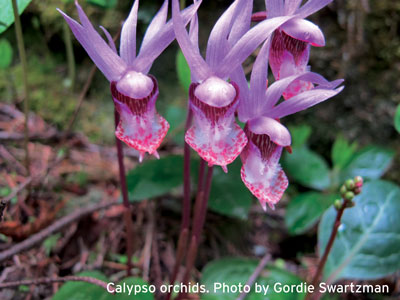
The Easton Ridge hike passes through three life-zones, including the east side Douglas fir-hemlock zone, the higher and more easterly mountain hemlock, subalpine fir zone and the higher low alpine zone along the ridge crest. As we moved higher we continued to see woods flowers, as calypso orchids are replaced by lupine and arnica.
The vegetation became sparser and the ground appeared dry, yet the flowers continued. Many were squat and appeared to be hugging the ground, in part for protection from the strong winds that buffed the ridge, as in all alpine areas. As we entered the lower subalpine area, splotches of color appeared to spread randomly over the patchy ground. It is a fragile habitat and we trod more carefully. The display was colorful and not understated. Highlights were the flaming smooth or snow douglasia, and the showy cliff penstemon. There was a lot of flower variety here and we wondered how an area so dry can produce so much diversity. We passed a large bear scat — a sign that we were not the only animals passing through the area.
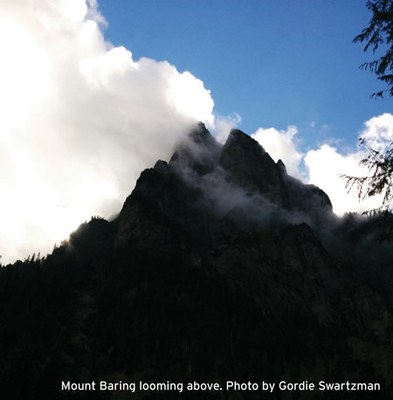 We moved along the ridge, ambling and gawking at flowers and views of Mt. Stuart. As we moved east we returned to the woods below the ridge and it was dryer, yet with signs of taller species, such as the western spring beauty and the glacier lily, species that come in just after (or during) snowmelt. Many of these early flowering species have the ability to raise the temperature around them several degrees and melt the snow so that they can come up through it. The slightly higher ridge at the east end of the trail offered many rocky outcrops with views of Mt. Stewart, Lake Cle Elum and Mt. Rainier.
We moved along the ridge, ambling and gawking at flowers and views of Mt. Stuart. As we moved east we returned to the woods below the ridge and it was dryer, yet with signs of taller species, such as the western spring beauty and the glacier lily, species that come in just after (or during) snowmelt. Many of these early flowering species have the ability to raise the temperature around them several degrees and melt the snow so that they can come up through it. The slightly higher ridge at the east end of the trail offered many rocky outcrops with views of Mt. Stewart, Lake Cle Elum and Mt. Rainier.
We lunched late in a rocky meadow with views on the edge of a meadow, and explored the rocks for new species. Many alpine and subalpine flower species are able to adapt to sparse, rocky soil, where few competitors are able to become established.
The way out is faster than the way in. In part we are spurred by rain squalls to the west which may be approaching us. We hurried on descent to try to reach the car before the rain might hit and were successful in doing so. Safe by the cars, we recapped what we saw, and investigated some flowers we didn’t know.
Opportunity Knocks
If you want to go on a hike with all your senses, and your interest is piqued by the natural world, you might want to join the Naturalists Study Group. In doing so, you will participate in learning and outdoor activities surrounding our shared love of nature. The best way to join the study group is to sign up for and graduate from our Introduction to the Natural World class, which begins in April and runs into August, with a four-evening lecture series and four field trips, some in town and some in the mountains.
Our lectures will familiarize you with how to identify flowers, birds, mammals, reptiles and butterflies, and introduce you to organizing concepts for nature study such as how the northwest was formed, how our geology and climate form life zones, and the organization of plants into families. The class concepts are emphasized by the field trips, which include a work day (and learning day) in our species garden, where many plants can be found blooming before they are ready to bloom in the wild (a great aid to plant identification). You can sign up for this class by visiting The Mountaineers website and clicking on Find Courses.
Another way to try out the Naturalists is to come on one of our hikes. Although we do have hikes exclusively for members of the study group, many of our hikes and field trips are open to all Mountaineers. You can do this whether or not you register for the course. Look for naturist hikes on the web page by clicking on 'Find Activities' under the Learn tab, then checking the exploring Nature Box. Although our pace, which can involve many stops at times, may not fit all hiking styles, if you truly are fascinated by nature and want to learn all that you can about it, you may well find your interest fits well with the Naturalists Study Group.
This article originally appeared in our Winter 2016 issue of Mountaineer magazine. To view the original article in magazine form and read more stories from our publication, click here.
 Gordie Swartzman
Gordie Swartzman
